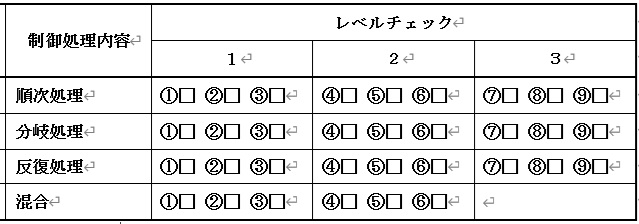プログラミングマスター ~アルゴリズムと共に~(C言語編)
― 徹底演習・復習による実力養成 ―
演習・確認問題を徹底的に解くことで、基礎と応用の定着を図ります。アルゴリズムの理解とC言語への実装力を一歩進めるコースです。

はじめに
プログラミングの学習を一通り終えたものの、「やっぱり難しい」「自分には向いていないのでは」と感じている方もいるのではないでしょうか。そんな方にこそ、本ノートを手に取っていただきたいと思います。ここで取り組むのは、“プログラミングのコツ”をつかむことです。
そのコツとは――ずばり「基本的な制御構造を理解する」ことです。「そんなことはもう知っている」と思われるかもしれません。しかし、本当に理解できているかどうかを、あらためてチェックしてみてください。
どんなに大規模なシステムや、小さなアプリケーションであっても、その中身はたった3つの制御構造(順次・分岐・反復)の組み合わせでできています。つまり、この3つをしっかり理解できれば、どんなプログラムでも設計・構築する力が備わるのです。
とはいえ、プログラムは「10人いれば10通り」の書き方があるものです。出された問題に対して、正しく動作するのであれば、それぞれのプログラムが正解です。だからこそ、無駄のないアルゴリズムを設計し、誰にとっても見やすい、洗練されたコードを書く――そんな“質の高く、美しいプログラミング技術”が求められるのです。
本ノートは、教科書にある例題をなぞるのではなく、提示された課題を読み取り、その流れを自分で考え、設計し、そしてプログラムに落とし込むというステップで学習を進めます。
まずは、自分自身の現在地を知ることから始めましょう。本書では、段階的にスキルを確認できる「レベルチェック形式」を取り入れています。「制御構造を本当に理解できているか」「どこが苦手で、どこを克服すべきか」が明確になり、自信を持ってアルゴリズム設計に取り組めるようになるはずです。
このノートを通じて、皆さんがプログラミングの楽しさを実感し、スキルアップを達成されることを心から願っています。
<レベルチェックリスト>
以下のリストを使って、自分がどこまでできるようになったかを確認していきましょう。各演習を終えるごとに、チェックを入れていくことで、自身の理解度や達成度がひと目でわかるようになります。

【Table of Contents】
1.順次処理:処理の基本「順番に実行する」
<レベル1> 表示処理の基本を学ぶ
<レベル2> 計算処理を順に実行してみる
<レベル3> 応用的な順次処理(実務系演習)
2.分岐処理:条件によって動作を変える
<レベル1> if文の基本(条件による出力)
<レベル2> 条件分岐の拡張(複数条件と比較)
<レベル3> 応用的な分岐処理(実践プログラム)
3.反復処理:同じ処理を何度も繰り返す
<レベル1> for文・while文の基本
<レベル2> 入力・処理を繰り返す演習
<レベル3> 多重ループと配列の活用
4.混合処理:順次・分岐・反復を組み合わせる
<レベル1> 制御構造の組み合わせ(短いプログラム)
<レベル2> 本格的なアルゴリズム演習

Programming Master: With Algorithms (C Language Edition)
— Building Solid Skills Through Intensive Exercises and Review —
By thoroughly working through exercises and review problems, this course aims to firmly establish both fundamental and advanced concepts. It is designed to advance your understanding of algorithms and strengthen your ability to implement them in C Language.
Introduction
Even if you have already completed an introductory programming course, you might still feel that “it’s difficult” or wonder “maybe it’s not for me.” This notebook is especially intended for those who feel that way. What you will work on here is grasping the essential knack of programming.
That knack can be summed up simply as understanding basic control structures. You may think, “I already know that.” But I encourage you to take this opportunity to check whether you truly understand them.
No matter how large a system is, or how small an application may be, its core is always built from a combination of just three control structures: sequential, branching, and looping. If you can thoroughly understand these three, you will gain the ability to design and build any program.
That said, programming is something where “ten people will write ten different solutions.” As long as the program works correctly, each approach can be valid. Precisely because of that, programmers are expected to design efficient algorithms and write code that is clear, readable, and well-crafted. In other words, what is demanded is high-quality, elegant programming.
This notebook does not simply have you follow along with textbook-style examples. Instead, you will read and understand the given problems, think through the process on your own, design a solution, and implement it in code step by step.
Let’s begin by assessing where you stand now. This book uses a level-check format that helps you verify your skills in stages. You will see clearly whether you truly understand control structures, identify your weaknesses, and know what you need to overcome. This will allow you to tackle algorithm design with greater confidence.
Through this notebook, I sincerely hope that you will discover the joy of programming and achieve real progress in your skills.

〒569-0088
大阪府高槻市天王町4-1 広本ビル1階
株式会社ワイドブック
代表取締役 廣本寿夫
072-691-6667
080-5036-1468(携帯電話)
say@widebook.net
https://www.widebook.net/